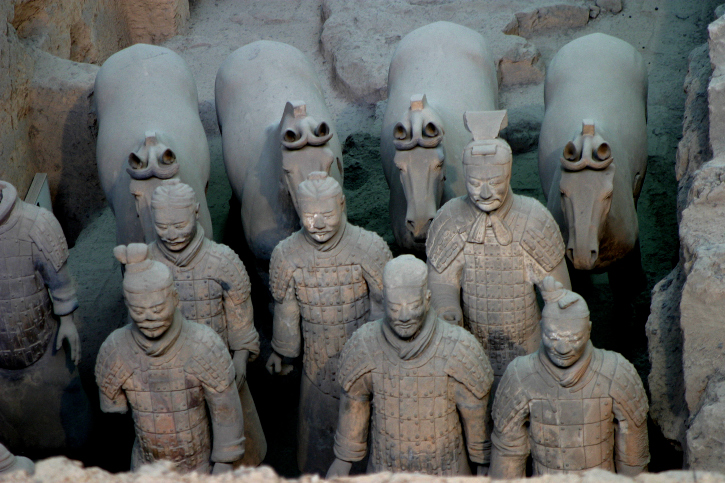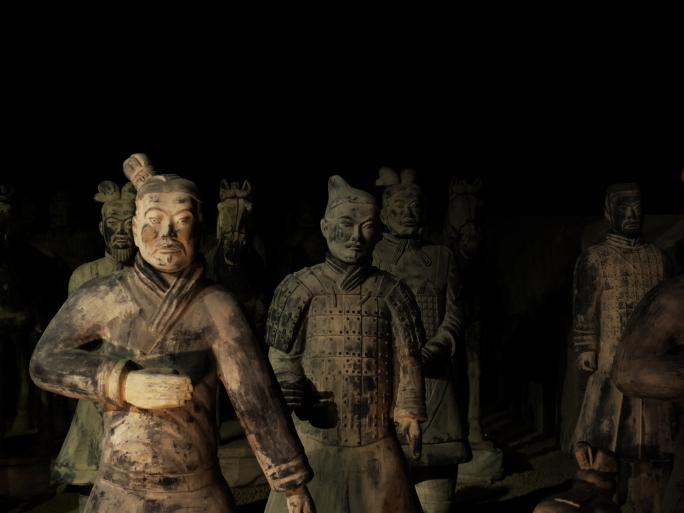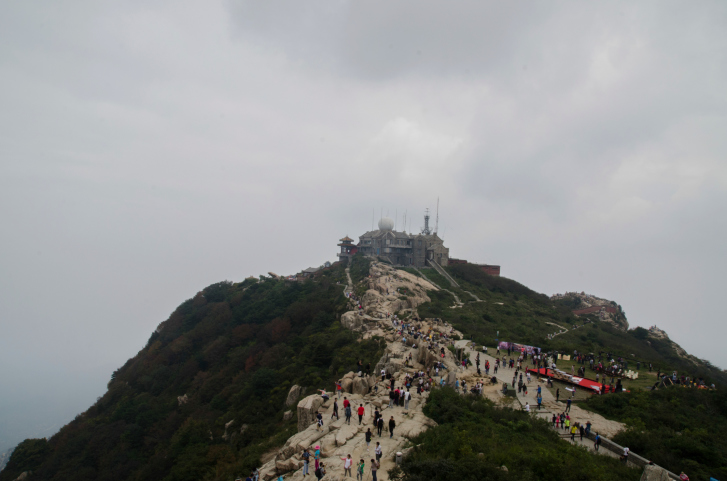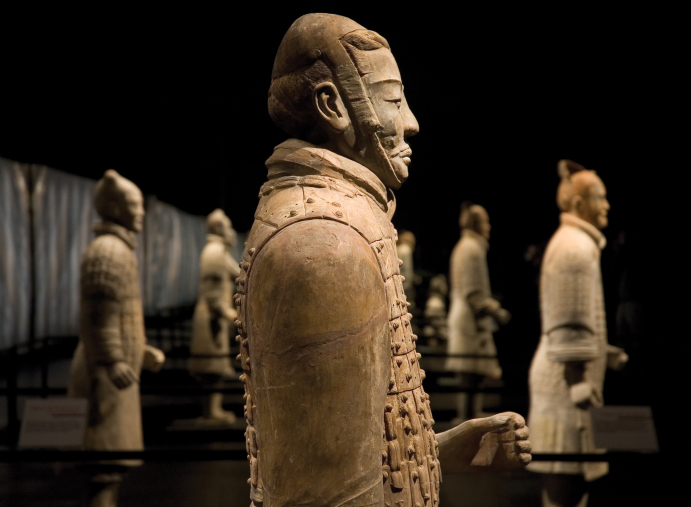(单词翻译:单击)
In 1974, a handful of impoverished Shaanxi farmers were digging a well when they stumbled across one of the most incredible archaeological finds in history: thousands of unique terra-cotta warriors standing guard over the tomb of China's first emperor. The legendary Qin Shi Huang united the warring states of China and built the magnificent tomb—and the stories of his life are just as fascinating as you'd expect.
1974年的某天,陕西省临潼县的几个农民正在打井,却无意中邂逅了考古史上最令人惊叹的奇迹——秦始皇陵兵马俑。数千个风格迥异的兵马俑屹立千年,守护着中国第一位封建帝王的陵寝,规模之宏大,蔚为壮观。秦始皇横扫六国,一统宇内,修建皇陵,极尽奢华。他用自己的一生书写了一部传奇,令人心驰神往。
10.Building The Tomb
10.秦始皇陵兵马俑

Most people are familiar with the terra-cotta warriors, each with their own unique features and armed with a variety of weapons. But the true scale of the tomb is almost impossible to comprehend, especially considering its construction began around 246 B.C.
秦始皇陵兵马俑被誉为"世界第八大奇迹",闻名遐迩。每个陶俑都具有独特的风格与迥异的武器配备。事实上,秦始皇陵兵马俑规模之宏大远超大家想象,这点从其修建时间便可见一斑:秦始皇陵始建于公元前246年,修建时间共持续37年。
The entire complex hasn't even been excavated yet, but archaeologists believe it sprawls over 56 square kilometers (21 mi2) and includes around 600 individual sites. In addition to the terra-cotta soldiers, with their horses and chariots, there are sections of the tomb dedicated to less militaristic figures. There are terra-cotta government officials, terra-cotta musicians with their instruments, acrobats captured in mid-tumble, and even a section mimicking the emperor's worldly court—complete with terra-cotta birds. Work on the complex began when the future Qin Shi Huang rose to a princely throne at the age of 13. Craftsmen from across China were recruited for the massive project and as many as 720,000 laborers were drafted to build it.While Qin Shi Huang's own final resting place hasn't been found yet, it's rumored to be even more incredible than the rest of the complex. Legend claims it's surrounded by deadly rivers of mercury. Worryingly, high levels of mercury have actually been found in the soil around the tomb complex. Not content with rivers of death, Qin Shi Huang's successor ordered that many of the tomb's craftsmen be sealed inside it, ensuring that the first emperor's burial place would be shrouded in secrecy.
秦始皇陵至今尚未全部发掘,考古学家认为该陵墓绵延56平方千米,共包含各类陪葬坑约有600处。秦代主张以武力强国,因此秦始皇陵中有大量配备马车与双轮战车的陶俑,富有"战国主义"色彩。除此之外,陵墓中还有代表不同风格的陶俑,比如:朝中大臣、演奏乐器的伶官、翻滚跳跃着的杂技演员,甚至用陶俑再现了秦代法庭的模样。秦始皇自13岁即位,就开始在骊山修建大型奢华陵墓。全国各地的精兵巧匠参与了这场浩大的工程,有72万人被征募参与了陵墓的修建。尽管秦始皇的"寝宫"陵墓至今尚未发现,但据说其"寝宫"比已发现的陵墓更奢华百倍。传说秦始皇骊山陵有象征汪洋大海川流不息的"水银之河",是用机械灌注水银而成。唯一令人担忧的是,秦始皇陵附近的土地被检测水银含量超标。为了确保秦始皇的"寝宫"骊山陵的位置能成为永久的秘密。秦二世将参与修建的工人全部埋葬在陵墓之中,无人逃脱陪葬的命运。
9.The Dynasty Only Lasted 15 Years
9.秦朝统治仅持续了15年

When the Warring States period ended in 221 B.C., the victorious King Zheng of Qin renamed himself Shi Huangdi. Today, he's usually referred to as Qin Shi Huang, or "First Qin Emperor." But in spite of his massive achievement in unifying China, his dynasty only lasted 15 years. In other words, construction work on his tomb lasted longer than the Qin dynasty ruled China.
公元前221年,战国时代结束,中国步入封建大一统.秦国嬴政一统六国,建立秦朝,自称"始皇帝".今天,我们通常称他为"秦始皇"或"秦朝第一位皇帝".尽管秦始皇一统中国,功勋卓越,但秦代统治在历史上仅延续了15年,是名副其实的短命王朝.换句话说,秦朝统治时间竟比秦始皇陵兵马俑的修建时间还要短。
Qin Shi Huang died suddenly in 210 B.C., leaving almost nothing in place to dictate what should come after him. It was only on his deathbed that he declared his oldest son his heir, a decision that didn't sit well with his closest advisers. Needing to keep the emperor's death a secret while they maneuvered to get his second son into power, his advisers subsequently hid his body in a wagon of rotting fish, knowing that the smell would mask the scent of his corpse.Spurred on by a string of natural disasters and the brutal Qin rule, the people revolted. Civil war ensued, and it wasn't until 202 B.C. that the Han Dynasty would be established and life truly went on. Ironically, during his short reign Qin Shi Huang had dubbed his dynasty "the Empire of a Thousand Generations."
公元前210年,秦始皇还来不及指点秦代未来江山社稷,就在第5次东巡途中暴毙死亡。令人疑惑的是,秦始皇即位后未立太子,直到死前才在病榻上宣布其继承人。遗憾的是,秦始皇死前宣布的继承人并不符合秦代丞相赵高与李斯的心意。为了帮助秦二世胡亥篡权,他们需要隐瞒秦始皇死亡的事实,于是赵高与李斯将秦始皇的尸体丢在放死鱼的马车上,以死鱼的腐尸味道掩盖秦始皇尸体的气味。秦二世继承皇位后实施残虐暴政,自然灾害频发,百姓生活于水深火热之中。随后人民奋起反抗,陈胜吴广揭竿而起。直到公元前202年,汉朝建立,人民才能安宁地生活。秦始皇即位后,曾多次宣称秦朝统治将延续千年,如今想来,不禁有几分讽刺。
8.Rumors Of Illegitimacy
8.私生子的传言

According to the official story, the man who would become Qin Shi Huang was the son of King Zhuangxiang and a concubine known as the Lady Zhao. After the death of the king, Lady Zhao took another lover, giving Qin Shi Huang the headache of two half-siblings. To make sure that neither ever challenged him, he had them both killed. For good measure, he also killed his mother's lover and had his mother arrested.
据正史记载 ,秦始皇是秦庄襄王与其小妾赵姬之子 。庄襄王薨逝后(译者注:指王侯之死) ,赵姬又有了一个情夫,还给秦始皇生了两个惹事生非的弟弟。为了确保他们不会威胁皇权,秦始皇把两个弟弟都杀了,另外他还处死了母亲的情人并软禁了自己的母亲。
Otherwise, not much is known about his early life or family, which may have helped the claims that he was actually illegitimate. Although the story is now considered doubtful, it comes from one of the definitive works of Chinese history, the Records of the Historian by Sima Qian. The author had inherited the position of court historian, choosing castration rather than death after angering a subsequent emperor. After his castration, Sima Qian went on to complete his work, including the story of Qin Shi Huang's true birth. Qin Shi Huang's father, according to the story, was actually a man named Lu Buwei, who would go on to be one of his advisers. A wealthy merchant, one of Lu Buwei's concubines had caught the eye of the king. Naturally, the merchant gave up the concubine—but she was already pregnant at the time. Lu Buwei knew this, taking solace in the fact that his son would one day inherit the kingdom.
另一方面,秦始皇早期的生活及身世不为世人所熟知。而这些情况表明,秦始皇实际上可能是个私生子。尽管这种说法现在广受质疑,但这一说法由司马迁所著的著名史书《史记》所载。司马迁袭父职继任太史令,由于触怒继任的皇帝,在处死和阉割两种刑罚中,他选择了后者。受阉割之刑后,司马迁继续完成他的著作,其中就有关于秦始皇真实身世的故事。据《史记》所载,秦始皇的生父是一个名叫吕不韦的男子,而吕不韦也是他的臣下之一。吕不韦曾是富商,有一次庄襄王看上了他的小妾赵姬。尽管那时赵姬已经身怀六甲,吕不韦也只能主动进献。吕不韦很清楚赵姬怀孕这一点,他只能自我慰籍他的儿子以后会继位成为诸侯王。
7.Mount Taishan
7.泰山

A UNESCO World Heritage site, Mount Taishan is one of the most culturally important places in China. The majestic mountain has been a sacred site since Neolithic times, and it was in part because of Qin Shi Huang that it continued to be so even after the unification of China.
作为联合国教科文组织评选的世界遗产,泰山也是中国最重要的文化景点之一。庄严雄伟的泰山自从新石器时期就是一处圣地。某种程度上泰山一直在扮演这种神圣的角色,甚至延续到秦始皇统一六国后。
Even today, the ruins of a massive rock wall can still be seen on the mountain, the last remnant of fortifications built by the State of Qin. After his victory, Qin Shi Huang himself scaled the mountain in order to pay homage for his victory. His pilgrimage began the practice of emperors climbing the mountain after coming to power, firmly establishing it as the cultural center of China. With its 6,600 stone steps, the mountain is host to centuries of historic artifacts, including 1,800 stone tablets and countless inscriptions. Mount Taishan, and the four surrounding mountains later became known as the Five Sacred Mountains, representing the original unification of China.
直到今天,山上还能看见大量的岩石城墙的废墟,这些仅存的防御工事是秦国修筑的。统一六国后,秦始皇亲登泰山,以昭示他的丰功伟绩。他的封禅仪式开创了后世皇帝即位必登泰山的先河,由此牢牢树立了泰山是中华文化中心的形象。6600级石阶蜿蜒而上,泰山拥有众多历史悠久的古迹,包括1800块碑碣和数不清的碑文。后来泰山及其余四座大山并称为家喻户晓的"五岳",共同代表着中国最初的统一。
6.The Strange Birth Of Legalism
6.法家的奇怪诞生

Qin Shi Huang ruled through the principle of legalism. Simply put, legalism dictates that people must earn what they get and pay the price for doing something wrong. Accomplishments lead to promotions and wealth, while making a mistake or breaking the law leads to punishment. Laws need to be clearly stated and public, and the only way to get ahead in life is by following the rules. One of the most famous legalist reformers was Shang Yang, who first presented his theories to King Xiao of Qin. According to the story, the philosopher appeared before the king three times to impart his wisdom. On the first two occasions, the king fell asleep midway through the discussion. The third time, Shang Yang tried a different tack and talked about the use of military might to enforce the law. That got the king's attention, and a fourth meeting for Shang Yang, where the details of legalism were hashed out.
秦始皇以法家学说治国。法家学说施行虽简单,却规定了劳有所得、有错必罚;提出"功当其事,事当其言,则赏;功不当其事,事不当其言,则罚";要求法律规定明确、公布于众,而人们晋升的唯一道路就是遵纪守法。商鞅是法家的代表人物之一,他是第一个向秦孝公提出法家的理论的人。传说商鞅三见孝公,畅谈变法治国之策。在前两次见面中,秦孝公都在讨论中昏昏欲睡。第三次,商鞅尝试了用不同的游说方式,他谈论了关于法律在军队中应用的问题。这勾起了秦孝公的兴趣,于是在第四次和商鞅的会面中,律法实施的细节问题在反复讨论中被敲定。
In theory, some of the principles Shang Yang advocated don't sound that bad. The old aristocracy was abolished, replaced with those loyal to the central government. The government itself was centralized, and merit was rewarded. Less popular was the division of the population into small family groups of 5 or 10, with the understanding that if one member did something wrong, the others needed to report it to the government or receive the designated punishment of being cut in half. Ironically, Shang Yang ultimately found himself the victim of some aristocratic plotting and was sentenced to be torn apart by five chariots.
在理论上,商鞅的一些主张并没有听起来那么糟糕。他提倡废除旧贵族,取而代之的是那些对朝廷忠心的臣民,提出朝廷作为集权的中心,倡导有功必赏,建议家庭人口以更细的单位划分,每个家庭5个或10个人,同时附带一个规则:当一个成员做错了事,另外的人需要向官衙报告,否则就会被处以腰斩的刑罚。讽刺的是,商鞅最后是被一些贵族密谋陷害,五马分尸而死。
翻译:小飞侠 来源:前十网


